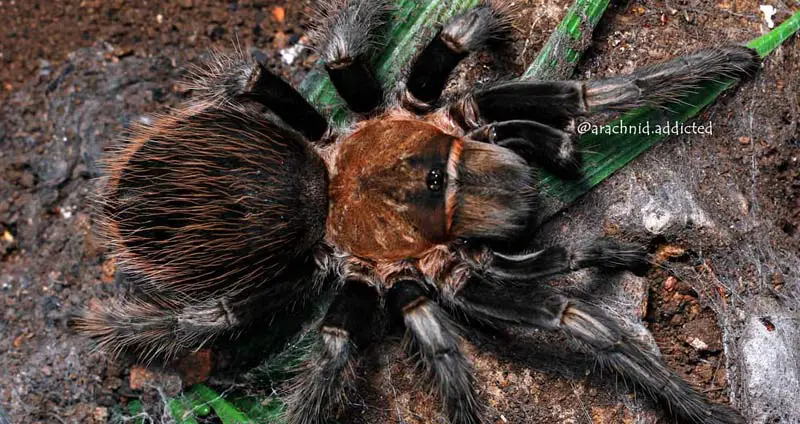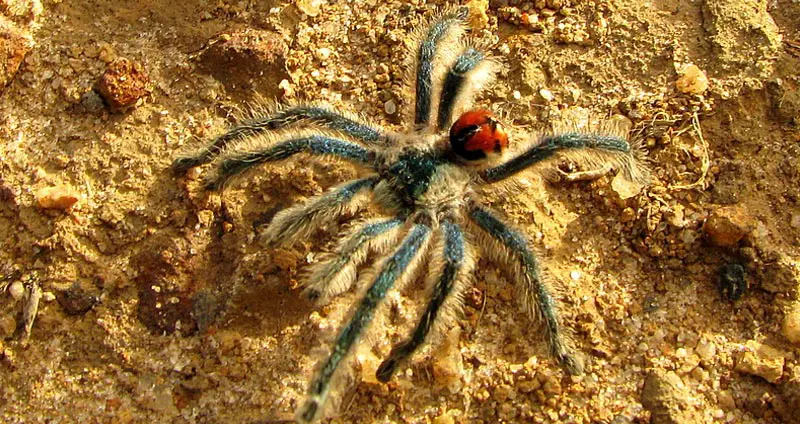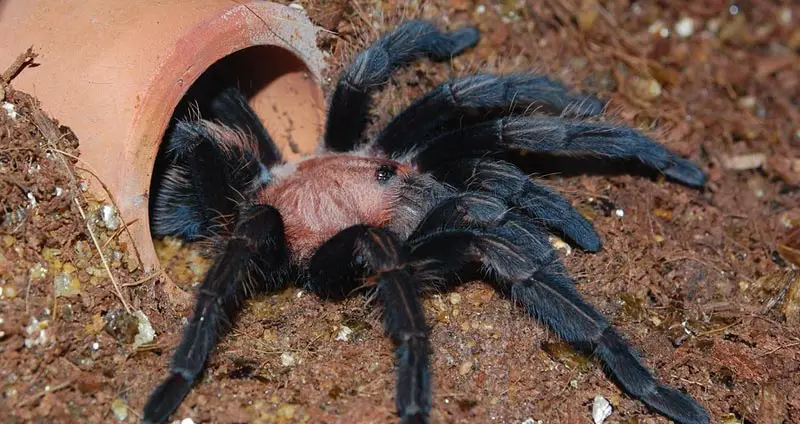If you’re looking for a decently friendly tarantula that’s very fun to own and visually-appealing, you should find many types to choose from. However, some of them stand out as the best.
In this article, we’ll introduce you to one great tarantula in particular — Brachypelma verdezi, or the Mexican Rose Grey tarantula. This care sheet will extensively cover this tarantula’s temperament and requirements for food and housing.
Note: This tarantula is now known as Tliltocatl verdezi
Table of Contents
Brachypelma verdezi Care Sheet
| | |
Common Name |
Mexican Rose Grey |
Species Type |
New world terrestrial |
Natural Habitat |
Found in Mexico where the climate is quite hot and humid almost year-round. |
Growth Rate |
Medium growth rate, growing about 1″ to 1.5″ per year. |
Adult Size |
Females reach a legspan of about 6″, with males measuring slightly smaller. |
Lifespan |
Females can live up to 15 years, while males often don’t live past 5 years. |
Enclosure |
The enclosure should be wider than it is tall with an emphasis on floor space. 6 inches of substrate should line the floor of the enclosure, and a hide and water dish need to be present. |
Temp/Humidity |
78°F to 82°F with about 75% to 85% humidity. |
Diet |
A ravenous eater that always puts on a show. Can eat an adult cricket several times per week, or about 2 dubia roaches per week. |
Temperament |
A very docile and friendly tarantula. Almost never threat poses or flicks hairs. Sits out in the open most of the time. |
Experience Level |
Beginner – Very easy to care for both in terms of environmental needs and temperament. |
Average Cost |
Slings ~ $60, Males ~ $100, Females ~ $150+ |
Brachypelma verdezi Appearance
The first thing you’d notice about the Mexican Rose Grey tarantula is their attractive appearance. Both males and females have distinct coloration on their dark-grey bodies.
For instance, the male Brachypelma verdezi has red and orange hairs on its black carapace. As for the females, they have a triangular marking on their abdomens.
Unfortunately, you won’t be able to enjoy the spectacular coloring of the males for long, due to their lifespan being between 4-6 years. Fortunately, females can live up to 15 years.
This discrepancy in lifespan is why many owners prefer to purchase females despite their slightly muted coloring.
In terms of growth rate, they’re right about average. Spiderlings are usually ¼ an inch in size, and grow an inch or two in a year.
With proper feeding and care, these spiderlings can grow into adults with a 6 inch legspan.


via @arachnid.addicted / Instagram
Brachypelma verdezi Temperament
The entire Brachypelma genus is well-known as a friendly, docile, and overall excellent type of tarantula for ownership. B. verdezi is no exception to this!
As a new world tarantula, they’re classified by their calm nature, friendly disposition towards their owners, and preference to run away from danger as opposed to fighting it. Therefore, you’ll rarely see this tarantula throw up threat poses or flick hairs.
However, they still do possess the ability to fend for themselves. Therefore, you should take caution when interacting with Brachypelma verdezi, as you wouldn’t want a face full of urticating hairs.
Handling is often practiced with this tarantula, but it can’t necessarily be recommended.
Aside from this, the Mexican Rose Grey tarantula is great for display purposes. They spend a lot of time above the surface in their enclosure, and they always put on a show when it’s feeding time.
Housing Brachypelma verdezi
Housing Brachypelma verdezi should be pretty easy, since they originate from Central America. So, providing the atmosphere needed for their comfort doesn’t require a lot of effort.
All that you have to do is get a reliable enclosure and fill it up with what your tarantula needs.
Optimal Brachypelma verdezi Enclosure
As these tarantulas are burrowers, you need to make their enclosures revolve around this behavior.
You should start by getting an enclosure that provides plenty of floor space. This enclosure should also be fit for at least 5 inches of substrate, and several more inches above for a bit of climbing space.
As Brachypelma verdezi grow to be 5-6 inches, they’ll need all this extra space. Additionally, since they tend to practice burrowing every now and then, they would need special decorations.
We suggest getting the Exo Terra 18″ × 18″ × 12″ terrarium or the Repti Zoo 20″ x 12″ x 10″ enclosure. Both of these enclosures provide plenty of floor space, ventilation, accessibility, and security — all very important aspects of a tarantula enclosure.
Enclosure Decorations
You should make sure the decorations match the natural instincts of your Brachypelma verdezi. You can achieve this by buying a few supplies.
They are occasional burrowers, so the substrate must be at least 5 inches deep. Use a high-quality, moisture-retaining substrate like coconut fiber so that it keeps the enclosure clean and fresh yet humid.
This species tends to hide a lot in its early years. Therefore, you should include a tarantula hide inside the enclosure. Later on, as it grows to be about 3 inches, it tends to spend much more time outside of its burrows and hides.
Another thing to remember is that you should always provide your tarantula with a water bowl. Like all species, tarantulas need to drink water. Water bowls also work to maintain humidity levels within the enclosure.
Enclosure Humidity/Heating
Originating from Central America, the ideal temperature for a Brachypelma verdezi is between 75°-82°F. This should be no trouble since it’s about room temperature for most people.
However, if the temperature gets too low, you should consider installing a heater. You can either utilize a gentle heat lamp that doesn’t emit light or a simple space heater.
As for the recommended humidity, it must be between 75% and 85%. In order to keep the atmosphere inside the enclosure humid, you should regularly spray the substrate with water to dampen it.
You should also overfill the water dish and let it dampen the substrate around it. These two methods will keep the enclosure nice and humid without getting swampy.
It’s important to monitor the temperature and humidity of the enclosure closely with a thermometer/hygrometer so that you can make changes as needed.
Diet
Mexican Rose Grey tarantulas are avid eaters. You’d be impressed by their appetites!
In the wild, they can eat almost any average-sized insect. For that reason, you should start by feeding your spiderlings flightless fruit flies. This is their ideal choice if they’re still ¼ an inch in size.
When they grow to be ½ an inch, you could start feeding them pinhead crickets.
As adults, they could eat adult crickets, grasshoppers, moths, earthworms, or roaches. You’ll find out they have big appetites, as they can eat up to 2 dubia roaches or 5 fully-grown crickets every week.
Health Concerns
As with most tarantulas that are captively kept as pets, there are no serious health concerns when it comes to the Mexican Rose Grey as long as their enclosure is optimal and diet is complete.
It is possible for pet tarantulas to experience both dehydration and mite infestations, but both of these problems are easily prevented and avoided.
Another danger to pet tarantulas is a ruptured abdomen — the side effect of falling even short distances. This is often fatal, so it’s important that you never let your Brachypelma verdezi fall from any height.
Brachypelma verdezi For Sale & Price
If you’ve been intrigued by this amazing tarantula, you should consider buying it. You’re lucky, because the Mexican Rose Grey isn’t among the most expensive tarantulas. In fact, it’s far from it!
The price for a ¾ inch Brachypelma verdezi tarantula should be somewhere between $50 and $70. Adult females can fetch about $150 to $200+. Although you should consider the overall cost needed to keep a tarantula, this is a fairly good price.
Due to their lack of popularity, you may not find these tarantulas for sale very frequently. However, when you do, the prices should be accessible for most, if not all potential owners.
For such a low price, this is an excellent tarantula to add to any collection. It has the laid-back attitude of the Brachypelma species with a great appearance and fun personality that anyone would love to own.

